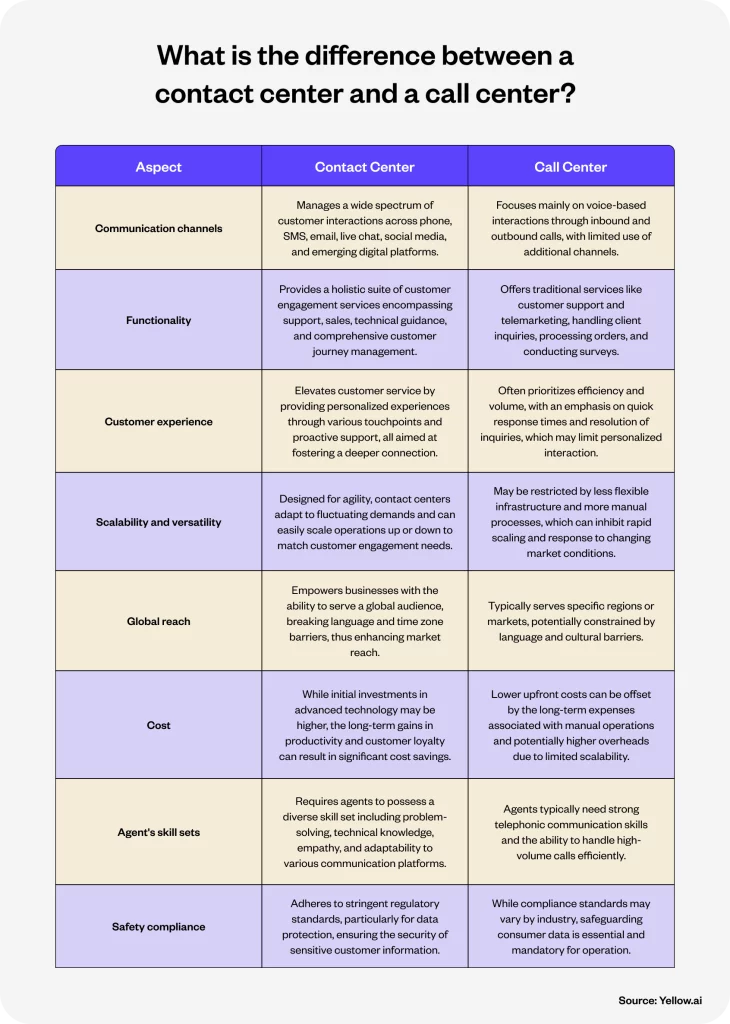Executive summary
Does your business handle customer service? If so, understanding the difference between “contact center” and “call center” is crucial, especially as these terms are often mistakenly used interchangeably. While both serve as hubs for managing customer interactions, they differ significantly in scope and functionality. This blog will lay out the distinctions between contact centers and call centers, to help business leaders like you make informed decisions to best meet the evolving customer service needs.
In today’s rapidly changing service landscape, automation within contact centers is becoming increasingly critical. According to a recent Automation in the Contact Center survey, 91% of leaders are prioritizing automation to manage rising costs, labor challenges, and surges in contact volume. Remarkably, about 95% of contact center leaders have already embraced or plan to implement automation technologies. These shifts are not just trends but necessities for adapting to new customer service dynamics. By exploring these technological advancements, this post will provide you with insights into how contact centers and call centers differ, and how they could revolutionize your business approach to customer service.
What is a call center?
Think of a call center as the original customer service cavalry. It’s a centralized hub, typically equipped with rows of agents, all geared towards tackling customer inquiries. Visualize a bustling room filled with a dedicated team of human agents, headsets firmly on, tackling a series of customer inquiries exclusively over the phone calls. That’s the essence of a call center. It’s a reliable workhorse, perfect for businesses where phone support remains king.
Related must-reads:
- Customer service in a call center: A detailed guide
- 31 Call center metrics and KPIs to enhance the CX
- Call center software – A Complete Guide [2024]
- Call center automation – Types, benefits and steps to implement
Strength and limitations
Call centers have their set of advantages and constraints.
Strengths:
- Focus and expertise: Agents hone their phone skills, becoming adept at resolving issues quickly.
Limitations:
- Channel silo: Customers seeking support via web chat or social media are left out in the cold.
- Limited data: Without a holistic view of customer interactions, understanding their journey becomes fragmented
Do you know that the industry call center turnover averages 30-45%? Human agents face consumers’ range of emotions, productivity stress, and inadequate compensation. High turnover affects customer experience, revenue, operational expenses, and, ultimately, staff morale.
Call center tech stack
Modern call centers aren’t just a room full of phones; they’re equipped with a group of tools to enhance efficiency:
- Interactive Voice Response (IVR): The friendly robot that greets callers, routing them to the right agent.
- Automatic Call Distributor (ACD): Ensures available agents evenly distribute calls.
- Call queuing: Keeps callers informed of their wait time, preventing hang-ups and frustration.
- Real-time dashboards: Supervisors can monitor call volume and agent performance and identify areas for improvement.
What is a contact center?
A contact center is the modern-day command center for managing customer interactions across multiple channels in our increasingly digital world. It’s designed to handle not just voice calls but a wide array of communication methods, making it indispensable for businesses aiming to provide comprehensive and responsive customer service. Let’s dive deeper into the functionalities that make contact centers a vital component of today’s customer service landscape.
Related must-reads:
- What is contact center compliance? [+Checklist]
- Top 10 contact center automation trends for 2024
- Contact Center as a Service (CCaaS) – Features and benefits
- Contact Center Automation: Benefits, Types and Examples
Diverse communication channels of a contact center:
Phone calls: Traditional yet essential, phone calls remain a cornerstone of customer service.
Text messages (SMS): Effective for quick communications like appointment reminders, despite a decline in popularity among younger demographics.
Emails: Crucial for detailed communications, providing a record of interactions and resolutions.
Video calls: Ideal for situations where visual engagement is necessary, enhancing personal connection and troubleshooting.
Social media: A dynamic platform for engaging with customers directly and publicly, addressing queries and managing the brand’s online reputation.
Live chat: Offers instant support for website visitors, facilitating real-time problem-solving and enhancing user experience.
Automated escalations: AI-driven technologies streamline routine queries through chatbots and voice agents, allowing human agents to focus on more complex customer needs.
A contact center integrates these varied channels into a unified agent interface, enabling seamless transitions between different modes of communication. This integration ensures a consistent and smooth customer experience, irrespective of the chosen interaction channel.
Leveraging AI and Data in Contact Centers
Beyond managing real-time communications, modern contact centers are equipped with advanced analytics to harness data from every customer interaction. This data is invaluable for:
Forecasting: Anticipating peak times and adjusting staffing levels to maintain service quality.
Strategic planning: Identifying areas for improvement and optimize your customer service strategy.
Agent performance improvement: Utilizing recordings and real-time feedback to refine agent skills and effectiveness.
By 2025, it’s projected that AI will drive 95% of all customer interactions, according to Servion Global Solutions. This shift underscores the increasing reliance on AI technologies to not only manage but also improve the contact center operations, ensuring businesses can meet evolving customer expectations efficiently.
What is the difference between a contact center and a call center?
The distinction between a contact center and a call center is found in the breadth and adaptability of the communication channels they use. Call centers, with their roots in traditional phone systems, focus on voice interactions, serving as the backbone of customer service for decades. In contrast, contact centers represent the evolution of customer service, aligning with the digital preferences of today’s consumers by facilitating seamless communication across a myriad of platforms including email, social media, live chat, and beyond.

| Aspect | Contact Center | Call Center |
| Communication channels | Manages a wide spectrum of customer interactions across phone, SMS, email, live chat, social media, and emerging digital platforms. | Focuses mainly on voice-based interactions through inbound and outbound calls, with limited use of additional channels. |
| Functionality | Provides a holistic suite of customer engagement services encompassing support, sales, technical guidance, and comprehensive customer journey management. | Offers traditional services like customer support and telemarketing, handling client inquiries, processing orders, and conducting surveys. |
| Customer experience | Elevates customer service by providing personalized experiences through various touchpoints and proactive support, all aimed at fostering a deeper connection. | Often prioritizes efficiency and volume, with an emphasis on quick response times and resolution of inquiries, which may limit personalized interaction. |
| Scalability and versatility | Designed for agility, contact centers adapt to fluctuating demands and can easily scale operations up or down to match customer engagement needs. | May be restricted by less flexible infrastructure and more manual processes, which can inhibit rapid scaling and response to changing market conditions. |
| Global reach | Empowers businesses with the ability to serve a global audience, breaking language and time zone barriers, thus enhancing market reach. | Typically serves specific regions or markets, potentially constrained by language and cultural barriers. |
| Cost | While initial investments in advanced technology may be higher, the long-term gains in productivity and customer loyalty can result in significant cost savings. | Lower upfront costs can be offset by the long-term expenses associated with manual operations and potentially higher overheads due to limited scalability. |
| Agent’s skill sets | Requires agents to possess a diverse skill set including problem-solving, technical knowledge, empathy, and adaptability to various communication platforms. | Agents typically need strong telephonic communication skills and the ability to handle high-volume calls efficiently. |
| Safety compliance | Adheres to stringent regulatory standards, particularly for data protection, ensuring the security of sensitive customer information. | While compliance standards may vary by industry, safeguarding consumer data is essential and mandatory for operation. |
Technological differences between contact center and call center
You should now be able to see that each of these customer service facilities is designed to do a certain task. Apart from the above dissimilarities, there are also a few distinct technological differences between the contact center and call center. Understanding these can help you decide which one works better for your business. Let’s compare their technical abilities and the table below explains it lucidly.
| Criteria | Contact Center | Call Center |
| Integration with CRMs | Integrates seamlessly for a comprehensive view of customer profiles and interactions. | Limited CRM integration can disrupt data continuity and inquiry processing. |
| Workflow management | Utilizes automation and efficient routing algorithms to minimize manual tasks. | Less automated, relying on manual call routing and resolution processes. |
| Analytics | Harnesses advanced analytics to assess and enhance customer interactions. | Basic analytics focus on call volume and processing times for reporting. |
| Tech integration | Leverages cloud solutions, AI, and automation for operational optimization. | Traditional setup with minimal automation capabilities. |
| Interaction management | Manages various interactions through an integrated agent interface. | Dependent on IVR and call distribution systems for routing. |
Call center or contact center — which is better for customer service?
In a market where businesses are rapidly adopting omnichannel strategies to provide seamless, 24/7 customer service, it’s essential to consider how a call center or contact center aligns with your growth and service goals. Call centers, once the industry standard for managing customer calls, might now hold you back from scaling to meet modern customer service expectations that extend far beyond voice communication.
If your business is still relying on a call center, you might find it challenging to keep up with the continuous, integrated engagement that today’s customers demand. High turnover rates in call centers can further strain your resources, leading to gaps in service and increased training costs.
Here’s the crux of the matter: the real choice isn’t just between a traditional call center and a contemporary contact center—it’s about deciding whether to stick with the status quo or evolve into a super-charged, AI-powered customer service powerhouse. This transformative leap is made possible with the right end-to-end customer service automation platform.
An AI-powered contact center isn’t merely an upgrade; it’s a complete reinvention of customer engagement. It equips you with sophisticated tools for analytics, automates routine inquiries with chatbots and voice agents, and personalized customer interactions with machine learning. The shift to such a platform ensures your customer service is not only proactive but also predictive, delivering solutions that anticipate customer needs.
As the contact center industry surges towards a $132.92 billion valuation by 2028, your forward-thinking decision to implement an AI-powered platform positions your business at the leading edge of customer service technology.
Choose wisely.
Take your customer service from sufficient to exceptional!

How Yellow.ai platform can help you automate your customer service?
Whether you are opting for a call center or a contact center, Yellow.ai’s customer service automation can streamline and improve it, making it more user-friendly. Our automation frees up human agents and empowers them with summarized data from an automated call, mapping customer journeys and giving a personalized approach to simple to complex interactions and problems.
How Yellow.ai’s customer service automation enabled Randstad to surpass client expectations.
Uniform experience across omnichannel
Enable your contact center to deliver a consistent experience across channels with our omnichannel automation. It facilitates this service for 35+ channels.
40% increase in CSAT
Customers may communicate with businesses whenever, wherever, and however they choose with the Dynamic Automation Platform (DAP). This boosts customer satisfaction by 40%.
Linguistic reach with over 135+ global languages
Businesses may use Yellow.ai to provide service in over 135 languages and dialects to reach a wider global audience. The industry’s first foundational LLM trained on 8.5B + Indonesian and local language tokens, our Komodo-7B, supports 11+ regional languages.
60% reduction in operation cost
Are you worried about the operation cost of your contact center or call center? Our voice automation, which sounds human-like, can cut operation costs by 60%.
20+actionable insights to enhance customer engagement
Get 20+ real-time actionable insights to boost customer engagement. Our AI analytics facilitate successful decision-making for businesses by using consumer conversations.
Conclusion
As we have reached the end of this blog, you have understood the fundamental differences between a contact center and a call center. Based on their salient features, you can choose the one that suits your business needs, budget and target customers. Having said that, the dilemma lies not in preferring a conventional call center and an advanced contact center but in whether to remain stagnant or transform into a customer service behemoth driven by artificial intelligence. A proper end-to-end customer service automation platform enables this evolution. A contact center powered by AI reinvents client engagement. Moving to this platform guarantees that your customer service is proactive and predictive, providing solutions anticipating customer wants. This is especially important as technology changes in tandem with modern customers’ expectations and needs.
















